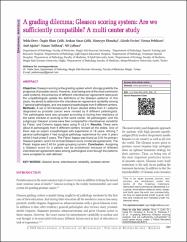A grading dilemma; Gleason scoring system: Are we sufficiently compatible? A multi center study

View/
Date
2020Author
Dere, YeldaÇelik, Özgür İlhan
Çelik, Serkan Yaşar
Ekmekci, Sümeyye
Evcim, Gözde
Pehlivan, Fatma
Çulhacı, Nil
Metadata
Show full item recordAbstract
Objective: Gleason scoring is the grading system which strongly predicts the prognosis of prostate cancer. However, even being one of the most commonly used systems, the presence of different interobserver agreement rates push the uropathologists update the definitons of the Gleason patterns. In this study, we aimed to determine the interobserver agreement variability among 7 general pathologists, and one expert uropathologist from 6 different centers. Methods: A set of 50 Hematoxylin & Eosin stained slides from 41 patients diagnosed as prostate cancer were revised by 8 different pathologists. The pathologists were also grouped according to having their residency at the same institute or working at the same center. All pathologists' and the subgroups' Gleason scores were then compared for interobserver variability by Fleiss' and Cohen's kappa tests using R v3.2.4. Results: There were about 8 pathologists from 6 different centers revised all the slides. One of them was an expert uropathologist with experience of 18 years. Among 7 general pathologists 4 had surgical pathology experience for over 5 years whilst 3 had under 5 years. The Fleiss' kappa was found as 0.54 for primary Gleason pattern, and 0.44 for total Gleason score (moderate agreement). The Fleiss' kappa was 0.45 for grade grouping system. Conclusion: Assigning a Gleason score for a patient can be problematic because of different interobserver agreement rates among pathologists even though the patterns were accepted as well-defined.

















